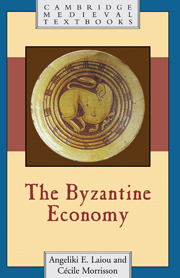Book contents
- Frontmatter
- Contents
- List of maps
- List of figures
- List of tables
- Acknowledgements
- List of abbreviations
- Introduction
- I Natural and human resources
- II The Late Antique economy and the shift to medieval structures (sixth–early eighth centuries)
- III Restructuring, recovery and controlled expansion (early eighth to tenth centuries)
- IV The age of accelerated growth (eleventh and twelfth centuries)
- V Small-state economics (from sometime in the thirteenth century to the fifteenth century)
- VI The Byzantine economy as exemplar; the Byzantine and the Western medieval economies
- Select bibliography
- Index
- Cambridge Medieval Textbooks
III - Restructuring, recovery and controlled expansion (early eighth to tenth centuries)
Published online by Cambridge University Press: 05 June 2012
- Frontmatter
- Contents
- List of maps
- List of figures
- List of tables
- Acknowledgements
- List of abbreviations
- Introduction
- I Natural and human resources
- II The Late Antique economy and the shift to medieval structures (sixth–early eighth centuries)
- III Restructuring, recovery and controlled expansion (early eighth to tenth centuries)
- IV The age of accelerated growth (eleventh and twelfth centuries)
- V Small-state economics (from sometime in the thirteenth century to the fifteenth century)
- VI The Byzantine economy as exemplar; the Byzantine and the Western medieval economies
- Select bibliography
- Index
- Cambridge Medieval Textbooks
Summary
By 700 the Empire had lost Africa, the last of its wealthiest provinces (Carthage fell in 698), and ceded the plains between the Danube and Haemus to the Bulgars (681). It was reduced to fragmented holdings in Italy, to coastal outposts around the Balkan peninsula and isolated ones on the Black Sea. Its core consisted now of two “pillars”: the islands – Sicily, Crete and the Aegean ones – and Western Asia Minor. No part of the territory was immune from hostile incursions. Only its powerful walls, fleet and Greek fire prevented Constantinople, besieged four times in 100 years, from falling into the hands of its strongest enemy, the Arab caliphate.
Undoubtedly the eighth century in Byzantium, was a difficult one, characterized by depopulation, de-urbanization, diminished production and reduced trade, accompanied by a marked decrease in monetization as we saw above. The economy was now based on different urban centres, smaller fortified kastra with downsized hinterland and decreased demand for primary and secondary products, and on different relations between peasants and landowners. Society evolved accordingly with the replacement of the former senatorial and municipal elites by a new ruling class. The hard times lasted until the end of the eighth century when the improvement on the military front, the restoration of control in the Balkans and stabilization of the frontier in Asia Minor in conjunction with a turn in the demographic trend signal the beginning of recovery. The role of the Isaurian dynasty (717–802) in this process of restructuring was instrumental.
- Type
- Chapter
- Information
- The Byzantine Economy , pp. 43 - 89Publisher: Cambridge University PressPrint publication year: 2007



